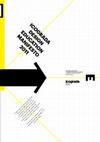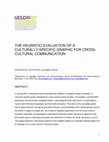Books: Monographs by Audrey G Bennett
No longer passive spectators of images, these days we are more likely to be active participants i... more No longer passive spectators of images, these days we are more likely to be active participants in their production, distribution, and consumption, which raises important questions about the consequences of widespread user interaction on meaning, communicative effectiveness, and society at large. In this groundbreaking book, communication expert Audrey G. Bennett argues that engendering interaction with images actually improves their effectiveness by enabling images to convey meanings effectively across cultures. At the cutting edge of the visual and communicative arts, this book represents a welcome challenge to the way we think about how images convey meaning.
Books: Edited Collections by Audrey G Bennett

""The Icograda Design Education Manifesto, a key legacy of Oullim, is a core document that define... more ""The Icograda Design Education Manifesto, a key legacy of Oullim, is a core document that defines Icograda's position on design education. The Manifesto advocates that design education must be a learning-centred environment, enabling students to develop their potential in and beyond academic programs.
The Icograda Design Education Manifesto was developed in 2000 as collaboration by an international group of designers. Participants represented a geographically, politically, economically, culturally, and socially diverse cross section of the design education community. Prof. Ahn Sang-Soo led the project which was translated into seventeen languages and presented at the Icograda Millennium Congress Oullim 2000 Seoul.
The 2011 edition of the Icograda Design Education Manifesto marks the 10 anniversary of this core document. Co-edited by Audrey Bennett and Omar Vulpinari, it is published in the six UN official languages. Additional translations are welcome and will be added as an online resource.
ICOGRADA""

In an age of globalization and connectivity, the idea of "mainstream culture" has become quaint. ... more In an age of globalization and connectivity, the idea of "mainstream culture" has become quaint. Websites, magazines, books, and television have all honed in on ever-diversifying subcultures, hoping to carve out niche audiences that grow savvier and more narrowly sliced by the day. Consequently,the discipline of graphic design has undergone a sea change. Where visual communication was once informed by a designer's creative intuition, the proliferation of specialized audiences now calls for more research-based design processes.
Designers who ignore research run the risk of becoming mere tools for communication rather than bold voices. Design Studies, a collection of 27 essays from an international cast of top design researchers, sets out to mend this schism between research and practice. The texts presented here make a strong argument for performing rigorous experimentation and analysis. Each author outlines methods in which research has aided their designwhether by investigating how senior citizensreact to design aesthetics, how hip hop culture can influence design, or how design for Third World nations is affected by cultural differences. Contributors also outline inspired ways in which design educators can teach research methods to their students. Finally, Design Studies is rounded out by five annotated bibliographies to further aid designers in their research. This comprehensive reader is the definitive reference for this new direction in graphic design, and an essential resource for both students and practitioners.
Papers by Audrey G Bennett
Design and Culture, Nov 1, 2010

Design and Culture, Mar 1, 2011
created the opportunity for consumer empowerment via individual solar subsidies. Not only is this... more created the opportunity for consumer empowerment via individual solar subsidies. Not only is this issue debatable, considering the aggregation of capital and resources that engendered such individual empowerment, but it also invites further comment about the role of design and engineering in helping individuals cope with the new landscape of energy consumption in an affordable way. Higgins is at her most deft when she weaves together twentiethcentury art, design, and cultural history. In “Box,” the chapter that is likely the most relevant to design historians (except for perhaps “Type”), her expertise allows for seamless transitions between examples as diverse as the history of shipping containers, Buckminster Fuller’s architecture of critical rejection, the geometry of Cezanne, Braque, and Picasso, the full-blown abstraction of Malevich and Mondrian, Sol LeWitt’s theatrical cubic constructions, Joseph Cornell’s nostalgic curations, and the playful organization of Fluxus artist George Brecht. This engaging book is a welcome addition to the cultural history of forms, and its method a suggestive one for historians of design.
... 2 4. Emotive images of a child © Audrey Bennett 5. Ocean horizon © Audrey Bennett 6. Tunnel a... more ... 2 4. Emotive images of a child © Audrey Bennett 5. Ocean horizon © Audrey Bennett 6. Tunnel at Dartmouth College © Audrey Bennett Chapter 3 7. Meta-poster image © Nathan Porteous, Chris Kerr, Katie Francoeur, Andrew Emerson, Alix Broomfield Chapter 4 8. AIGA Get out ...

In spring 2007, multicultural users evaluated the usability of a graphic design exemplar-a cultur... more In spring 2007, multicultural users evaluated the usability of a graphic design exemplar-a culturally-specific graphic designed for cross-cultural communication. The graphic-an HIV/AIDS awareness and prevention campaign poster-was designed three years prior in a participatory manner with third world laypeople and first world educators. The intent of the campaign poster was to effect behavior change among other Kenyans (and potentially other cultural groups around the world) in regard to unsafe sex. As a result of feedback generated from the cross-cultural, heuristics evaluation, we developed a web-based interactive poster that aims to allow first and third world users to customize the poster and distribute it to others via email, cell phone, or print. This paper presents a case study analysis of the usability testing of a culturally-specific poster and its redesign into a cross-cultural, interactive poster.
Abstract This paper introduces emotive aesthetics as visual language that expresses and/or evokes... more Abstract This paper introduces emotive aesthetics as visual language that expresses and/or evokes an emotion or a series of emotions from the target audience for a rhetorical purpose.(eg persuading them to make a positive change in a life-threatening behaviorial pattern). Historically, political graphics have been popular examples of products that use emotive aesthetics to promote positive social change. However, there's a problem today with the lack of time graphic designers have to devote their skills to the continued development ...
Design and Culture, Nov 1, 2010

Critical interventions, 2012
The golden ratio, a mathematical relation that often arises in fractals and other scaling geometr... more The golden ratio, a mathematical relation that often arises in fractals and other scaling geometries, is known for its ability to effect visual beauty.1 As a result, communication designers have used it throughout history to compute a plethora of visual compositions. For instance, many designers use the golden rectangle, a popular compositional grid derived from the golden ratio, to organize verbal and visual information into eye-catching images. However, within the discipline’s literature, our European predecessors, primarily ancient Greece, receive most of the recognition for being the sole contributors to the use of the golden ratio. Very few references in the discipline’s literature acknowledge Africa as the one of the primary contributors to knowledge about the golden ratio. In this paper, I challenge the assumption that the golden rectangle originated solely in ancient Europe and I examine existing evidence within broader interdisciplinary discourse, which suggests that the golden rectangle is more of an outcome of interaction between African and European civilizations. Herein, I respond to Robert Bringhurst’s The Elements of Typographic Style, Kimberly Elam’s Geometry of Design, and Tim Samara’s Making and Breaking the Grid: A Graphic Design Layout Workshop, by noting that African contributions are conspicuously absent in their accounts. My aim is to weave into the discourse other perspectives from anthropology, architecture, and mathematics, which suggest that Africa’s golden ratio exemplars predate the instances that have created the current origin story. Specifically, I introduce perspectives that suggest that the structures derived from the golden ratio, which organize typographic compositions and even structure living spaces, were also present in traditional African architecture, and that this presence extends further back than sites and artifacts in Greece. Two important examples derive from Ron Eglash’s analysis: the first is the chief ’s palace in Logone-Birni, Cameroon, a historical architectural site that has a golden ratio scaling pattern embedded in its spatial design; the second is a similar scaling pattern in the Temple of Karnak from ancient Egypt.2 These additions of African design into the story of the golden ratio need not be limited to merely correcting an incomplete history. We can use them to broaden perspectives on how the golden ratio can be used and to encourage its incorporation in the design of images that aim to communicate cross-culturally. From existing cultural artifacts and spatial designs that reflect the golden ratio and other patterns, we can extract cultural grids—a phrase I introduce to explain the phenomenon of grids found in cultural artifacts and man-made or natural spaces, which can apply to communication design practice, particularly to the printed or digital page. When used in the design of information, these cultural grids, I posit, may yield crosscultural resonance during the interpretation of images in the communication process.
Design Issues, Jul 1, 2002
The process of graphically designing communication artifacts used to be a personal activity, depe... more The process of graphically designing communication artifacts used to be a personal activity, depending upon the creative impulse of an individual—the graphic designer. 1 The graphic designer traditionally behaved as the representative of the audience. Only a trained and competent graphic designer could make the client's vision accessible to the prospective audience by re-communicating our common cultural signs and symbols in new visual contexts. 2 Possessing an intrinsic ability to communicate visually by innovatively ...
In this essay, I reflect on a teaching experience that made me ask "what are the standards for go... more In this essay, I reflect on a teaching experience that made me ask "what are the standards for good design in a socially conscious age?" My reflection describes an experience I had teaching engineering majors about what constitutes good design. I then compare that experience with another experience teaching graphic arts majors the practical aspects of graphic design. Through these experiences, I had an epiphany that good design establishes credibility, stimulates use and facilitates ease of use in a public context, includes the user, resonates with the culture of users, and sustains humanity or the environment. My reflection concludes with an explanation of each criterion.

International Journal of Web-based Learning and Teaching Technologies, Oct 1, 2013
The phrase "broadening participation" is often used to describe efforts to decrease the race and ... more The phrase "broadening participation" is often used to describe efforts to decrease the race and gender gap in science and engineering education, and in this paper the authors describe an educational program focused on addressing the lower achievement rates and career interests of underrepresented ethnic groups (African American, Native American, and Latino students). However "broadening participation" can also describe the more general problem of a narrow, decontextualized form of education that can alienate all demographics. Broadening the scope of computing education can not only help address disparities in different social groups, but also make technical education more attractive to all individuals, and help us create a generation of science and engineering professionals who can better incorporate an understanding of the world into their technical work. The program the authors report on, Computer Science Education from Life (cSELF) takes a modest step in this direction. Using the concept of "design agency" the authors describe how this merging of abstract formal structures, material creative practice, and cultural knowledge can improve underrepresented student engagement, and foster learning practices in computing that offer broader forms of social expression for all students.
Routledge eBooks, Apr 21, 2023
Routledge eBooks, Apr 21, 2023
Routledge eBooks, Apr 21, 2023
Routledge eBooks, Apr 21, 2023











Uploads
Books: Monographs by Audrey G Bennett
Books: Edited Collections by Audrey G Bennett
The Icograda Design Education Manifesto was developed in 2000 as collaboration by an international group of designers. Participants represented a geographically, politically, economically, culturally, and socially diverse cross section of the design education community. Prof. Ahn Sang-Soo led the project which was translated into seventeen languages and presented at the Icograda Millennium Congress Oullim 2000 Seoul.
The 2011 edition of the Icograda Design Education Manifesto marks the 10 anniversary of this core document. Co-edited by Audrey Bennett and Omar Vulpinari, it is published in the six UN official languages. Additional translations are welcome and will be added as an online resource.
ICOGRADA""
Designers who ignore research run the risk of becoming mere tools for communication rather than bold voices. Design Studies, a collection of 27 essays from an international cast of top design researchers, sets out to mend this schism between research and practice. The texts presented here make a strong argument for performing rigorous experimentation and analysis. Each author outlines methods in which research has aided their designwhether by investigating how senior citizensreact to design aesthetics, how hip hop culture can influence design, or how design for Third World nations is affected by cultural differences. Contributors also outline inspired ways in which design educators can teach research methods to their students. Finally, Design Studies is rounded out by five annotated bibliographies to further aid designers in their research. This comprehensive reader is the definitive reference for this new direction in graphic design, and an essential resource for both students and practitioners.
Papers by Audrey G Bennett
The Icograda Design Education Manifesto was developed in 2000 as collaboration by an international group of designers. Participants represented a geographically, politically, economically, culturally, and socially diverse cross section of the design education community. Prof. Ahn Sang-Soo led the project which was translated into seventeen languages and presented at the Icograda Millennium Congress Oullim 2000 Seoul.
The 2011 edition of the Icograda Design Education Manifesto marks the 10 anniversary of this core document. Co-edited by Audrey Bennett and Omar Vulpinari, it is published in the six UN official languages. Additional translations are welcome and will be added as an online resource.
ICOGRADA""
Designers who ignore research run the risk of becoming mere tools for communication rather than bold voices. Design Studies, a collection of 27 essays from an international cast of top design researchers, sets out to mend this schism between research and practice. The texts presented here make a strong argument for performing rigorous experimentation and analysis. Each author outlines methods in which research has aided their designwhether by investigating how senior citizensreact to design aesthetics, how hip hop culture can influence design, or how design for Third World nations is affected by cultural differences. Contributors also outline inspired ways in which design educators can teach research methods to their students. Finally, Design Studies is rounded out by five annotated bibliographies to further aid designers in their research. This comprehensive reader is the definitive reference for this new direction in graphic design, and an essential resource for both students and practitioners.